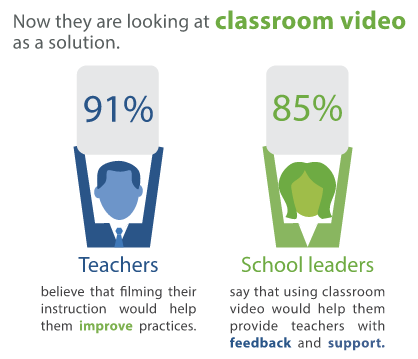Every year, millions of dollars – and even more hours – are spent on observations and evaluations in schools. Unfortunately, neither teachers nor school leaders seem to think it’s working the way it should.
At the District Administration Leadership Institute (DALI) conference in January, my colleague, Richard Nyankori, and I shared these two alarming statistics from a recent poll conducted with SmartBrief Education:
- When school leaders were asked if they believe their current evaluation systems promote teacher growth, 62% said no.
- Nearly 70% of teachers said that they do not get enough meaningful feedback from observations and evaluations.
Given the time and resources already dedicated to educator effectiveness systems – and the critical need for skilled teachers in every classroom – districts and schools must have a solution that actually connects teacher observation and growth.
And classroom video, as Richard and I explained to the audience, is quickly emerging as the way to make it happen.
Here are the five things we know about video in observation and evaluation and why it works:
-
Observers and teachers want instant replay.
Just as coaches and athletes rely on game film to analyze performance, video gives observers and teachers a chance to pause and rewind moments to truly see all the moving parts of a classroom.
Video provides the opportunity for teachers to choose lessons for feedback.
Research from the Measures of Effective Teaching (MET) Project has shown no statistically significant difference between the lessons teachers submit as their best work, and those that they didn’t choose. Furthermore, allowing teachers to select and submit lessons not only reinforces their confidence in the system, but encourages them to self-reflect and continuously work to improve their practices.
-
Video promotes fairness and accuracy of scoring.
According to culminating findings from the MET Project, video serves as a common piece of evidence to protect against rater bias. In the event of a dispute, teachers and observers can review the same video together and come to a mutual understanding.
-
Collective bargaining units approve of video for observation and evaluation.
Two of the largest teacher unions see video as a way to protect teachers and provide them with the high-quality support and feedback they deserve.
-
Video enables content-specific and actionable feedback.
It’s unrealistic to assume a single observer has the content-area expertise to provide relevant, specific feedback to all teachers in all subjects. Videos, however, can be shared with content experts from other departments or buildings. One district is even using videos for coaching from Insight’s expert coaches – and the results have been remarkable.







